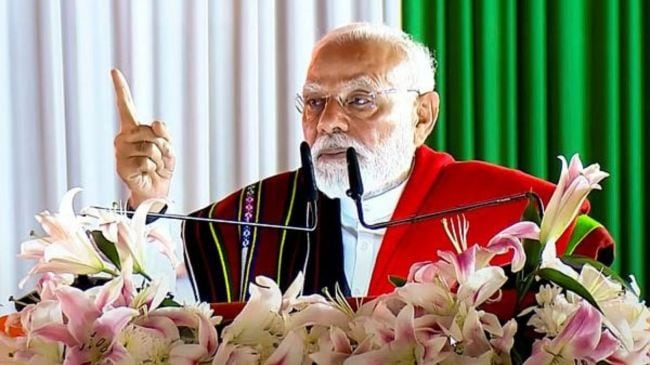Opinion PM Modi in Manipur: Impeccable choreography, silence on first principles
The trip has been thick with inaugurations and figures and thin where it counts. No dates to dismantle the levy points. No timetable for safe return
 Institutionally, the welcome was warm. On the ground, the mood split.
Institutionally, the welcome was warm. On the ground, the mood split. After 864 days of conflict, Prime Minister Narendra Modi visited Manipur. His first stop was Churachandpur, a tribal district that has borne some of the heaviest costs. Apex bodies of the Zomi and Kuki tribes issued rare, joint welcomes, an index of long neglect as much as anticipation. Potholes were hurriedly filled, roads were scrubbed, fences and arches rose along the expected route.
The administration and civil society moved as if it were a festive week. Even the macabre theatre of “dummy coffins” at the Wall of Remembrance was hidden, removed, restored and played out in bursts, as if the town were rehearsing grief and gratitude at once. By 8 pm on September 11, the surface-level unity had cracked, and unidentified youths reportedly tore down barricades and torched posters on the stretch the PM was likely to take. The point landed: Decoration is not deliverance.
On September 13, around 11.40 am, the Prime Minister landed in Imphal. By 12.15 pm, his rain-lashed convoy was on the road to Churachandpur after weather conditions scrapped the direct Aizawl–Churachandpur plan. Just before 1 pm, he reached Peace Ground under a heavy downpour, met internally displaced persons (IDPs), laid foundation stones, inaugurated works “throughout the state”, and addressed a gathering. Governor Ajay Kumar Bhalla called Churachandpur “a symbol of diversity and resilience”, urged “healing” through “dialogue and inclusivity”, and also claimed that as a border state, “we cannot afford our land to be encroached and inhabited from across the border”.
The Prime Minister opened his speech with “The land of Manipur is the land of courage and determination… I salute the spirit of the people of Manipur”, before focusing on development and connectivity. By 1.35 pm, he reached for imagery (“‘Mani’, a gem that will enhance the shine of the Northeast”) and restated that significant works had just been launched for hill communities in health and education. Security tightened across the state; he would return to the Imphal valley later in the day.
The trip has been thick with inaugurations and figures, and thin where it counts. No dates to dismantle the levy points. No timetable for safe return. No cases moving with names and charges. Custody, return, and justice did not figure in the speech. Until those assurances come with deadlines, the rest is ceremony, not remedy. Benefits are steered to the valley, and the displacement belt, Churachandpur and Kangpokpi/Sadar Hills, get token works. Development as a cure to the situation is the theme of the visit, as if roads and ribbon-cutting can act as a substitute for dialogue, justice and a plan for safe return.
Institutionally, the welcome was warm. On the ground, the mood split. In Churachandpur, welcome was conditional on whether the visit addressed the conflict that produced the IDPs. The listening gap told its own story. The town wanted not a longer dais but 10 minutes of hearing names, dates and locations put on the record. It didn’t come: No open slot for testimony, ward-level delegation, or even a brief face-to-face with party MLAs to carry specific petitions. Days of mobilisation, barricades, lighting, security layers and not 10 minutes for the epicentre to be heard.
The last mile is where promises fail. IDPs need safety and a credible plan to return; families need levy networks dismantled and kept down; survivors need cases that move with names, charges and dates. A promise of justice that involves punishing perpetrators, protecting witnesses and reporting progress publicly — that is the minimum a conflict-hit district expects when the state’s highest office flies in.
The standard defence is administrative economy: a Prime Minister cannot speak to everything everywhere, hence a composite roll-out of inaugurations and foundation stones. But this visit could have been the hinge. He met the IDPs, but did not set dates for relief and return, did not bind enforcement and justice to a timetable, and did not match development promises with safety measures. A history of long neglect persists: Impeccable choreography, silence on first principles. The only metric now is whether this conflict-ridden state can rebuild its life.
Hangsing is a researcher and writer based in Manipur





